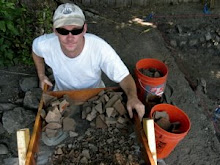Please check out the excellent blog Craig Wilson and his peers have created for the Quincy Smelter Association. Mr. Wilson has expanded the Quincy Smelter's Blog beyond a simple narrative about working to save the site. He and his collaborators have built this site into a major historical exhibit, showplace for photography, and a resource with organized information useful to both local people and potential visitors. The blog is exemplary and one I use when talking with people about the potential of new media for heritage preservation efforts.
My last post was about tourism, sustainable redevelopment, and industrial heritage. Here in Michigan's Copper Country, we have several excellent examples of industrial heritage sites with tremendous potential for the region's communities. Some sites have been preserved by local groups, like the Quincy Mine Hoist Association. Federal agencies continue to make important contributions to preservation and redevelopment at some key sites, most notably the National Park Service and the Environmental Protection Agency.
The smelter is a totally unique historic resource sitting in a well preserved landscape of great interest to many people. Don't believe me? Try these image searches on Google Image or on Flickr and here.
The cooperative model developing here requires local efforts-- locally funded, controlled, and advocated for by stakeholders-- coordinating with and assisted by national agencies like the National Park Service. There have been no "white knights" charging in to save the day here in the Keweenaw. Preservation of our industrial heritage has required planning, coordination, and small, "stepwise" thinking about efforts. Things have not gone perfectly or easily, but the smelter site has become a real symbol of renewed commitment and partnerships.
The National Park Service maintains a map of the participating historic sites.






